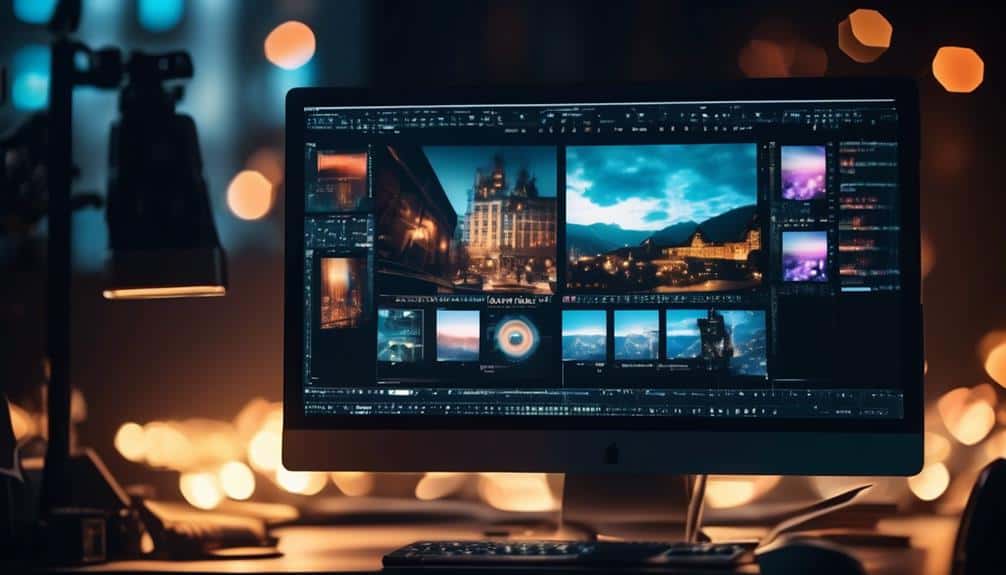Navigating Design Software: Tips and Tricks for First-Time Users
Ever found yourself lost in the labyrinth of design software, feeling like a modern-day Theseus trying to navigate the maze of tools and features? Fear not, for within this digital labyrinth lie shortcuts and secrets that can guide you to success.
As a first-time user, you may feel overwhelmed by the sheer complexity of design programs, but with a few expert tips, you can unravel the mysteries of these digital realms and unlock your creative potential.
Key Takeaways
- Master efficient navigation techniques to increase productivity.
- Customize shortcuts and workspace layout for a tailored design experience.
- Implement effective layer management strategies for a tidy workspace.
- Ensure software compatibility, troubleshoot issues, and optimize performance for smooth operation.

Enhance your design software proficiency with these essential shortcuts for swift and seamless navigation. By mastering advanced techniques, you can elevate your design workflow to new heights. Practical applications of these shortcuts include speeding up your design process, increasing productivity, and unleashing your creativity without constraints.
One key shortcut to remember is using the combination of keys to quickly duplicate elements. This allows you to experiment with different design variations without starting from scratch each time. Another essential technique is learning how to create custom shortcuts for frequently used tools, saving you valuable time in the long run. By incorporating these shortcuts into your workflow, you can navigate the software with ease and efficiency.
Imagine effortlessly moving between layers, adjusting settings on the fly, and executing complex commands with just a few keystrokes. These shortcuts empower you to work more fluidly and intuitively, unlocking the full potential of your design software. Mastering these essential shortcuts will revolutionize the way you approach design, giving you the freedom to create without limitations.
Understanding Key Features and Tools
Delve into the intricate world of design software by exploring its key features and tools that will elevate your creative capabilities. When you grasp the fundamental elements like brush settings and color palettes, you unlock a realm of artistic possibilities.
Let's break down these essential tools in a visually engaging table:
| Key Features | Description |
|---|---|
| Brush Settings | Customize size, hardness, and opacity to achieve varying strokes and effects. |
| Color Palettes | Access a spectrum of colors, create custom swatches, and experiment with gradients. |
Understanding brush settings allows you to refine the texture and style of your designs, from soft watercolor strokes to precise digital lines. On the other hand, mastering color palettes enables you to evoke emotions, establish harmony, and bring your creations to life with vivid hues. Embrace these tools, experiment freely, and watch your designs flourish with newfound depth and vibrancy!
Customizing Your Workspace for Productivity

Get ready to boost your design efficiency by optimizing your workspace layout with just a few simple tweaks.
Explore the myriad tool customization options available to tailor your software to your specific needs.
Create personalized shortcuts that streamline your workflow and supercharge your speed.
Workspace Layout Efficiency
Customize your workspace layout to boost your productivity and efficiency. Start by organizing your tool panel for easy access to frequently used functions. Arrange your workspace to maximize screen real estate, allowing for a clear view of your design without unnecessary clutter.
Utilize keyboard shortcuts to speed up your workflow and minimize mouse movements. By customizing your workspace, you can create a tailored environment that suits your design style and preferences, enhancing your overall experience with the software. Experiment with different layouts until you find one that optimizes your efficiency.
Tool Customization Options
Enhance your design workflow by tailoring the tools in your workspace to boost productivity and efficiency. Brush customization allows you to create unique brush styles that suit your design needs. Experiment with different brush shapes, sizes, and textures to achieve the desired effects swiftly.
Color palette customization enables you to organize your preferred colors for quick access, streamlining the color selection process. By customizing your color palette, you can work more seamlessly and maintain consistency across your projects.
Personalize your workspace by arranging your most-used tools for easy reach, further optimizing your workflow. Embrace the freedom to customize your design software tools, empowering yourself to work more effectively and creatively.
Personalized Shortcuts for Speed
Boost your design efficiency further by creating personalized shortcuts that cater to your workflow speed and productivity needs. By creating personalized workflows, you can significantly speed up tasks within your design software.
Consider customizing keyboard shortcuts for frequently used tools or actions, allowing you to execute commands swiftly without navigating through menus. Tailoring your workspace layout to prioritize essential tools can also streamline your workflow.
Additionally, take advantage of features like action macros or custom scripts to automate repetitive tasks and save time. Remember, the goal is to optimize your workspace for maximum efficiency, so don't hesitate to experiment with different shortcuts until you find what works best for you.
Your design process will become smoother and more fluid as you fine-tune your personalized shortcuts.
Mastering Layer Management and Organization

To master layer management and organization effectively in design software, start by establishing a clear naming convention for your layers. Consistent and descriptive names make it easier to identify and work with different elements in your project.
Here are some tips to help you navigate the world of layer organization:
- Color Code for Visual Clarity: Assign different colors to your layers based on their content or purpose. This visual cue can quickly indicate which elements belong together or need special attention.
- Utilize Grouping and Nesting: Group related layers together and consider nesting groups within other groups for a hierarchical structure. This technique helps maintain a tidy workspace, especially in complex projects.
- Mastering Blending Modes: Experiment with blending modes to control how layers interact with each other. Understanding and using blending modes effectively can elevate your designs by creating unique effects and visual styles.
Utilizing Templates and Presets Effectively
After establishing a clear naming convention and mastering layer management, the next step is to leverage templates and presets effectively for streamlined design workflows. Templates offer a starting point for your projects, saving time and providing structure. Customizing templates to suit your specific needs can enhance efficiency and creativity. On the other hand, presets within design software can help maintain consistency across your work. Utilizing preset libraries ensures that colors, styles, and effects remain uniform throughout your designs, creating a cohesive look. Drawing inspiration from well-designed templates can spark new ideas and approaches to your projects. By combining template customization for personal touch and preset libraries for design consistency, you can achieve a balance between efficiency and creativity in your design process.
| Templates | Presets |
|---|---|
| Provide structure | Maintain design consistency |
| Save time | Ensure uniformity |
| Enhance creativity | Spark new ideas |
| Customizable for your needs | Create a cohesive look |
Troubleshooting Common Design Software Issues

When encountering glitches or malfunctions in your design software, swift problem-solving techniques are crucial to maintain productivity and creativity. Here are some tips to help you troubleshoot common design software issues:
- Software compatibility issues, troubleshooting techniques: Check for updates or patches from the software provider to ensure compatibility with your operating system. If issues persist, consider reinstalling the software or seeking support from online forums.
- Resolving graphic driver conflicts: Update your graphic drivers regularly to prevent conflicts with your design software. If you experience issues, try rolling back to a previous version or contacting the graphic card manufacturer for assistance.
- Performance optimization strategies: Close unnecessary programs running in the background to free up system resources for your design software. Adjust settings within the software to optimize performance and consider upgrading hardware if performance issues persist.
Frequently Asked Questions
How Can I Easily Collaborate With Others on Design Projects Using Design Software?
To easily collaborate with others on design projects using design software, you can engage in real-time collaboration for remote teamwork. This allows for efficient design feedback and review processes, enhancing creativity and productivity in your projects.
What Are Some Best Practices for File Organization and Storage Within Design Software?
Keep your files tidy by using clear, descriptive names and organizing them in a logical folder hierarchy. Embrace version control to track changes. Utilize cloud storage for easy access and seamless collaboration with others.
Is It Possible to Integrate Design Software With Other Programs or Platforms for a Seamless Workflow?
You can boost productivity by integrating design software with other programs. Enjoy a seamless workflow and enhance compatibility. Streamline your tasks, unleash creativity, and conquer projects with ease. Let your work flow effortlessly.
How Can I Ensure My Designs Are Optimized for Different Devices and Screen Sizes?
To ensure your designs are optimized for different devices and screen sizes, focus on responsive design principles. Prioritize user experience by maintaining design consistency and verifying device compatibility. This approach guarantees a seamless and visually appealing experience across various platforms.
Are There Any Resources or Communities Where I Can Seek Help or Further Develop My Skills in Using Design Software?
Explore online tutorials and forums for skill sharing. Engage in workshops to enhance your design software proficiency. Find vibrant communities where you can seek help and further develop your skills. Embrace the journey to mastery.
Conclusion
You've now unlocked the secrets to navigating design software like a pro.
With essential shortcuts, key feature knowledge, and workspace customization, you're on your way to creating masterpieces with ease.
Remember to master layer management, utilize templates, and troubleshoot common issues to streamline your workflow.
Get ready to unleash your creativity and design like never before!








